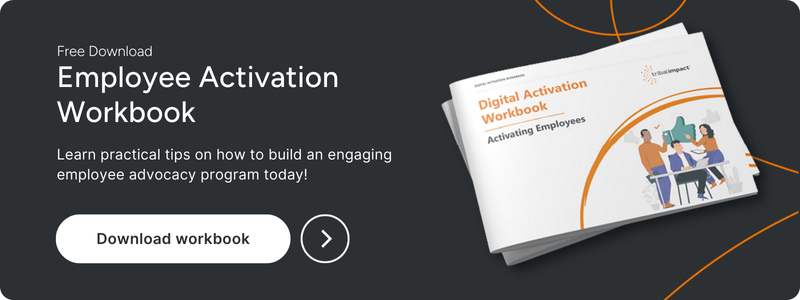Our weekly LinkedIn Lives series focuses on bringing together marketing, sales, and HR professionals to discuss their lessons in running employee activation programs on social media.
In one of our recent Lives, Sarah Goodall, Tribal Impact CEO, spoke to Liz Brenner, Head of Enablement Communications & Change Management at ServiceNow, about how businesses can embed a digital culture through enablement and change management.
You can watch the full interview here, or read the summary of what they discussed below.
What Is Change Management?
A lot of businesses think that to adopt a new digital culture, all it requires is a few training sessions. However, it’s really about mindset and skillset. Training isn’t enough without the accompanying enablement and change management.
Employees need to understand why things are changing and accept that it’s happening. Change management is the structured approach to implement and communicate this change.
As Liz put it: ‘you’re trying to bring people along for this ride to get them to really get out there, put themselves out there, so that they’re being these authentic brand advocates for a company, and that takes time.’
Leaders Should Set An Example
Leaders need to be role models, they have to demonstrate best practices so that employees can see that if their managers are doing it, they can too. This can create a wave of change from within.
You can’t expect everyone to be ready at the same time, so having a simple change strategy where you can assess what works, what’s resonating, and collecting feedback from people can really help.
Introduce a change champion network by bringing influencers and role models from across the company together and use them as a sounding board for feedback, getting them to raise their hand and say what works and what doesn’t. This can provide you with the awareness and understanding you need to grow the programme and their involvement will make it easier to bring more employees in.
Collect Data To Assess Change
Listening to your change champions will give you excellent qualitative feedback, but it’s always better to have a combination of both qualitative and quantitative data for change management.
Survey tools can also help you assess the readiness for change at the beginnings of a project and then you can measure how these numbers change throughout the project. This data can help you to understand what stages people are at in terms of accepting the change, which means you can tailor your training and focus on where additional resources are needed.
Explain What’s In It For Them
‘You can't have one leader come forth and say, hey, we're doing this and we're doing it differently. You've got to get down to the role level so people can understand what's the impact to them,’ Liz explained.
When you tell someone why something is happening, and how it’s important to them, they’re more likely to get onboard with the changes.
They’ll need to know things like:
- Why are we doing this?
- How does their role change?
- What will they need to do differently?
- How will it make their role better?
- How will it make their daily life better?
- Why do they want to do it?
The answers to these questions will be different depending on employees’ backgrounds and departments, but if you can tap into them and get employees to understand how the changes are positive for them, they’re going to be more enthusiastic and not feel like it’s just another change being dictated to them.
Create A Framework For People To Follow
If you can break it down into a change framework that employees can understand, it can become scalable.
You could create a toolkit that walks people through what’s happening. Each step should have tools and templates they can take and customise for their audience. This gives them something to fall back on, providing them with the key messages and everything they need to promote awareness of the change.
Remember: simple scales, complex doesn’t.
Support Your Line Managers
The first person an employee is going to speak to when a change happens to their role is their line manager. So, it’s important to make sure those managers are ‘well-prepared, well-versed, and understand what’s happening,’ said Liz. ‘That’s usually my first target audience to make sure managers are equipped to handle questions.’
It's even better if you can get managers involved in bringing the change to life for their team. Could they have a session with the team where they work through what it means for their roles together? That way, they get to hear about it from their own team and can work alongside their manager to make it apply to their day-to-day role.
Conclusion
Embedding a digital culture has to start from the top. Leaders and managers set examples that make employees feel more comfortable with the change and excited about getting involved.
But it's also a two way street. The same leaders need to be able to listen to employee feedback and use this to guide the change management process. Making employees feel like a part of the change encourages them to embrace it rather than hide from it.
By having leaders and line managers onboard, collecting the correct data, communicating effectively to employees and keeping it simple by introducing frameworks to follow, your program will have a much higher chance of being successful.


